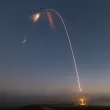Lift Off Time | September 10, 2023 – 12:47 UTC | 08:47 EDT |
|---|---|
Mission Name | NROL-107 or Silent Barker |
Launch Provider | United Launch Alliance (ULA) |
Customer | National Reconnaissance Office (NRO) and United States Space Force (USSF) |
Rocket | Atlas V 551 |
Launch Location | Space Launch Complex-41 (SLC-41) |
Payload mass | Not specified, up to 8,900 kg (19,600 lb) |
Where did the satellite go? | Unknown |
Did they attempt to recover the first stage? | No, this is not a capability of the Atlas V rocket |
Where did the first stage land? | It crashed into the Atlanic Ocean |
Were these fairings new? | Yes |
This was the: | – 1st launch of the Atlas V rocket in 2023 – 2nd mission for ULA in 2023 – 98th overall Atlas V mission – 157th overall ULA mission – First launch of Atlas V in 10+ months – 145th orbital launch attempt of 2023 |
Where to watch | Official livestream |
What’s All This Mean?
For the first time in nearly 11 months, an Atlas V will take to the skies over Florida yet again in the 18th and final launch of a National Reconnaissance Office mission on an Atlas V. Setting up for multiple Atlas V launches for the remaining months of 2023, NROL-107, also called Silent Barker, will be launched on the Atlas V 551 configuration. The Atlas V 551 configuration is often called “The Bruiser” because of its heavy-lift and thrust capabilities.
Launch will take place at Cape Canaveral Space Force Station, Florida, United States from Space Launch Complex 41 (SLC-41).

How Did It Go?
Without a hitch, the Atlas V 551 launch vehicle rapidly accelerated off from SLC-41 powerd by five solid rocket boosters and a RD-180 engine. ULA has stated that the launch was successful although not much more information has been given due to the classified nature of this payload.
What Is SILENT BARKER?
Due to the classified nature of NROL-107, a joint mission for the United States’ National Reconnaissance Office and United States Space Force, there is no readily available public information on the specifics of satellite operation and intended purpose. However, ULA states that the satellite will “improve space domain awareness”, indicating that there is technology on board to be able to detect and track objects around Earth, from a space-based station.
On the contrary, ground based tracking stations can oftentimes be inhibited by weather or other naturally occuring atmospheric and ionosphereic conditions. Data from this satellite, gathered and processed by the NRO, will enhance the United States’ ability to respond to potential threats and other events with greater knowledge than before.

As with every launch, ULA releases artwork with significance relating to the mission and its partners. For example, in the artwork above, the two shooting stars resemble the close collaboration between the United States Space Force and the National Reconnaissance Office. According to ULA, the fox represents the “cunning nature of the Intelligence Community (IC) and the Department of Defense (DoD) that gives our warfighters the edge against America’s adversaries”.
What Is The Atlas V?
The Atlas V is an expendable medium lift launch system and member of the Atlas rocket family. The rocket has two stages. The first is a Common Core Booster (CCB), which is powered by an RD-180 engine and burns kerosene (RP-1) and liquid oxygen (LOx). This is accompanied by up to five strap-on solid rocket boosters. The second stage is the Centaur upper stage, which is powered by one or two RL10 engines and burns liquid hydrogen (LH2) and liquid oxygen (LOx).
In the 551 configuration, the Atlas V is capable of carrying up to 8,900 kg to Geostationary Transfer Orbit (GTO).
What Does 551 Mean?
Atlas V rockets have a three-number configuration code. The first number represents the fairing diameter size in meters, so in this instance, there is a 5-meter fairing. The second number denotes the number of solid rocket boosters (SRBs), which attach to the base of the rocket. The number of SRBs for a 5-meter fairing can range from 0 – 5. In this case, there will be five SRBs attached to the center core. The third number shows the number of engines on the Centaur Upper Stage, which is one in this configuration. So this means that this rocket will have a 5-meter fairing, five solid rocket boosters, and one engine on the Centaur Upper Stage.





Graphic shows Atlas V HLV (triple core configuration) – Never flown – but did ULA propose it for any US govt launches ? What payload would it have to say GTO or TLI ?